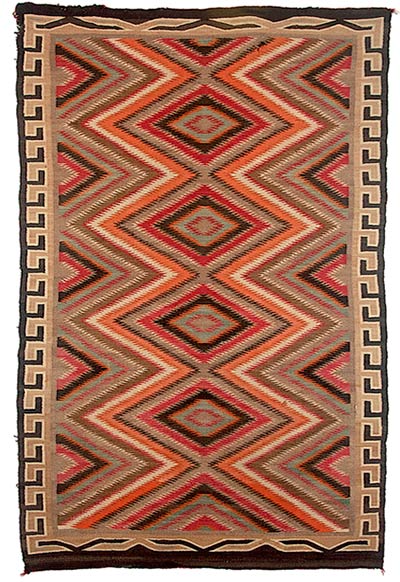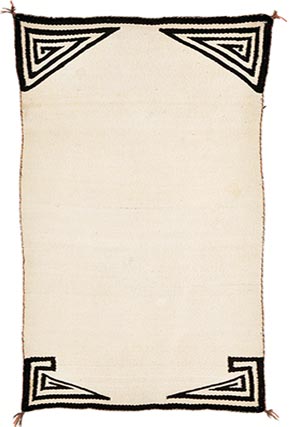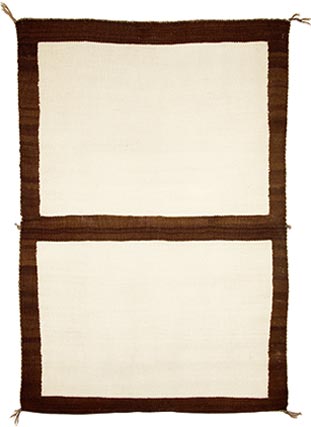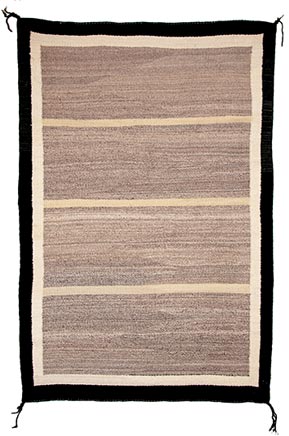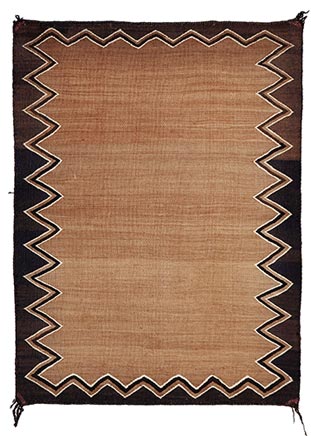What’s the Difference Between a Blanket and a Rug?
Navajo blankets were woven between 1750 and 1900. Navajo rugs were woven between 1890 and now. Blankets were made to be worn around the body, like shawls. Blankets were softer and more pliable than rugs. Rugs were made to be put on the floor, so rugs were coarse and more durable than blankets. Most blankets were woven without borders. Most rugs were woven with borders.
In blankets, designs run edge-to-edge. Chief’s blankets and mantas were woven wider-than-long. Serapes were woven longer-than-wide. Chief’s blankets and serapes were valuable trade items. Between 1800 and 1860, demand for Navajo chief’s blankets came from the Arapahoe, Cheyenne, Kiowa, Lakota, Shoshone, and Ute tribes. Demand for striped serapes came from the Hopi. Demand for bayeta serapes came from the Mexicans and the Spanish, though there were instances where bayeta serapes were acquired and worn by Navajo men and by Cheyenne men.
After 1860, demand for Navajo blankets came from Anglo-American buyers. Anglo-Americans’ design preferences were not the same as Native American preferences. Native Americans preferred simplicity in their blankets. Anglo Americans preferred complexity.
After the Mexican-American War of 1848, Anglo-American military expeditions started to arrive in the southwest. Between1850 and 1900, U. S. Army officers, engineers, mapmakers, politicians, railroad workers, and tourists collected classic, late classic, and transitional Navajo blankets, with the intention of taking them back to California, the Midwest, or the East Coast as souvenirs. Serapes were more popular with Anglo-Americans than chief’s blankets, but there was Anglo-American demand for third phase chief’s blankets, because third phases had more elaborate designs than first phases or second phases.
During the 1880s, Germantown eye-dazzler serapes became popular among Anglo-Americans visiting the southwest by train. During the 1890s, Anglo-American ranchers who’d settled in the Rio Grande Valley wanted floor rugs and saddle blankets for their houses and their horses. By 1900, the rug had replaced the blanket as a trade item. At railroad stations and trading posts in Arizona, Colorado, New Mexico, and Utah, there were still some blankets for sale, but the rug had become the preferred trade item.
After 1900, the majority of Navajo weavings were woven as floor rugs. Rugs were woven all through the 20th century. They’re still being woven today. 95% of historic and contemporary Navajo rugs were woven longer-than-wide, with bordered designs. Between 1900 and 1910, borders were simple. After 1910, borders became more decorative.
The wearing blanket has its origins in the Navajos’ history as a nomadic culture. Prior to 1865, Native Americans, including the Navajo, had territories but no tradition of owning property. Distance, landscape, and open space represented freedom. To weave a chief’s blanket or a serape with a border would have been contrary to the Navajo belief in the celebration and worship of open space.
The foundation of Anglo-American culture was the ownership of property. Borders were as familiar to Anglo-Americans as they were alien to Navajos. Anglo-Americans were familiar with Oriental carpets, which almost always have borders. Anglo-Americans liked bordered rugs because countries, states, cities, ranches, and lots were created, defined, and maintained by their borders. For an Anglo-American merchant, rancher, or tourist, a rug with a border was more valuable than a blanket with no border.
From Left to Right and Top to Bottom:
A Twilled Double Saddle Blanket with a White Field, Navajo, circa 1890.
A Double Saddle Blanket with White Windows, Navajo, circa 1890-1900.
A Double Saddle Blanket with Three Yellow Bands, Navajo, circa 1900-1910.
A Double Saddle Blanket with a Copper-Colored Field, Navajo, circa 1910.



